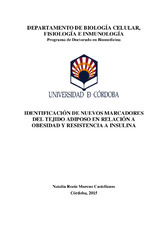Mostrar el registro sencillo del ítem
Identificación de nuevos marcadores del tejido adiposo en relación a obesidad y resistencia a insulina
| dc.contributor.advisor | Malagón, María M. | |
| dc.contributor.advisor | Vázquez Martínez, Rafael | |
| dc.contributor.author | Moreno Castellanos, Natalia Rocío | |
| dc.date.accessioned | 2015-12-03T12:30:47Z | |
| dc.date.available | 2015-12-03T12:30:47Z | |
| dc.date.issued | 2015 | |
| dc.identifier.uri | http://hdl.handle.net/10396/13150 | |
| dc.description.abstract | INTRODUCTION The adipose tissue (AT) has been long considered to play a passive role as a fat storage depot. However, recent discoveries have significantly modified the classical view of adipose tissue as an inert energy storage site and uncovered the complex regulation of adipose tissue lipogenesis and lipolysis (Rodríguez et al., 2011; Ràfols, 2014; Frühbeck, 2014; Burcelin, 2013). Likewise, it is now accepted that adipose tissue constitutes a primary site for glucose uptake in response to insulin (Havel, 2004). In addition, it has been clearly established that the adipose tissue represents a true endocrine organ that produces a wide variety of signaling molecules, the adipokines, endowed with important endocrine, paracrine and autocrine activities (Lanthier and Leclercq, 2014; Maury and Brichard, 2010; Frühbeck and Gómez-Ambrosi, 2005). Adipocytes are the main cellular component of the AT. These cells are embedded in a collagen matrix in which mesenchymal stem cells, pre-adipocytes, nerve endings, blood cells and vascular tissue are embedded too, composing the so-called stromal-vascular fraction (SVF) (Malagón et al, 2013). Both adipocytes and the SVF are necessary for the maintenance of the different functions of the AT. Mature adipocytes, which represent the main cellular component of AT, are responsible of triglyceride (TG) storage during periods of excess energy and mobilization of the stored lipids as free fatty acids (FFAs) to be used as an energy source by other tissues during times of negative energy balance. The lipid uptake and accumulation of FFA is positively regulated by insulin, which also promotes glucose uptake and is required as a substrate for glycerol synthesis and formation of TG (Bevan, 2001; Frühbeck, 2014). In contrast, catecholamines are major stimulators of the hydrolysis and mobilization of stored TG during fasting (Czech et al., 2013). Along with insulin and catecholamines, adipocyte lipid metabolism is regulated by other endocrine factors including natriuretic peptides, the gastrointestinal hormone ghrelin, or paracrine/autocrine factors released by adipocytes or the SVF such as tumor necrosis factor alpha (TNF-α), leptin, or IL-6 (Deng and Scherer, 2010; Halberg et al., 2008). In lipogenesis, FFA released from circulating lipoproteins by the action of lipases is up-taken by the adipocytes. Transmembrane lipid transfer requires the participation of a number of adapter proteins including fatty acid carrier proteins (FATP), the fatty acid translocase FAT/CD36 and fatty acid binding proteins (FABPs), both membrane-bound and cytosolic (FABPpm and FABPc) (Hotamisligil and Bernlohr, 2015). It is now known that FABPs are involved in the esterification of long chain fatty acids, interact with phospholipid membranes and FAT/CD36 and their expression is induced by insulin and fatty acids in adipocytes (Hotamisligil and Bernlohr, 2015). In these cells, both FAT/CD36... | es_ES |
| dc.format.mimetype | application/pdf | es_ES |
| dc.language.iso | spa | es_ES |
| dc.publisher | Universidad de Córdoba, UCOPress | es_ES |
| dc.rights | https://creativecommons.org/licenses/by-nc-nd/4.0/ | es_ES |
| dc.subject | Tejido adiposo | es_ES |
| dc.subject | Marcadores | es_ES |
| dc.subject | Obesidad | es_ES |
| dc.subject | Resistencia a insulina | es_ES |
| dc.title | Identificación de nuevos marcadores del tejido adiposo en relación a obesidad y resistencia a insulina | es_ES |
| dc.type | info:eu-repo/semantics/doctoralThesis | es_ES |
| dc.rights.accessRights | info:eu-repo/semantics/openAccess | es_ES |

